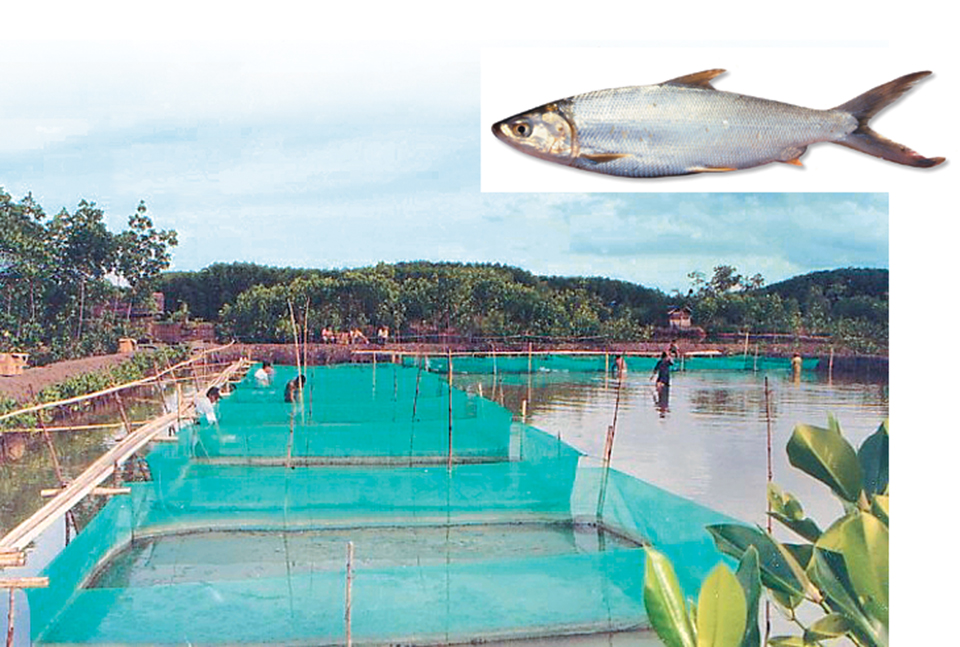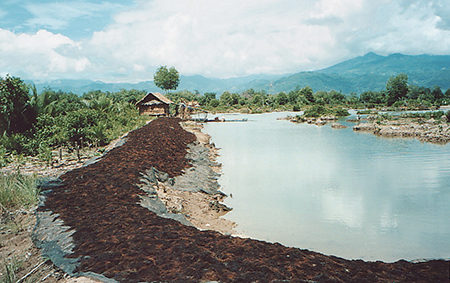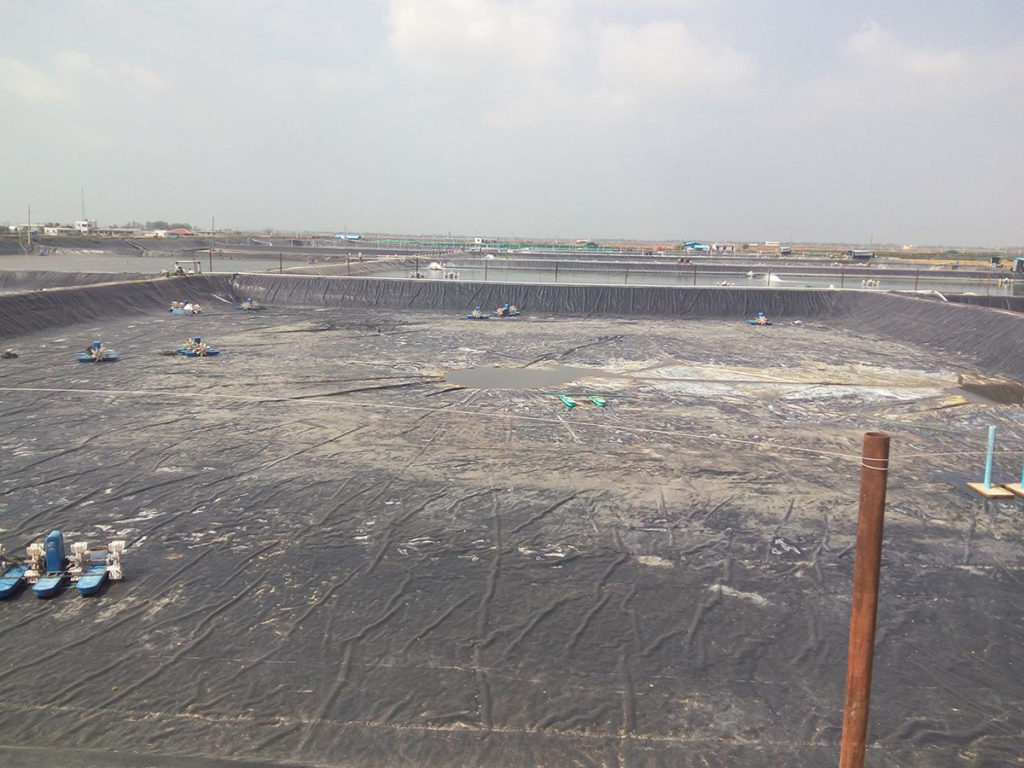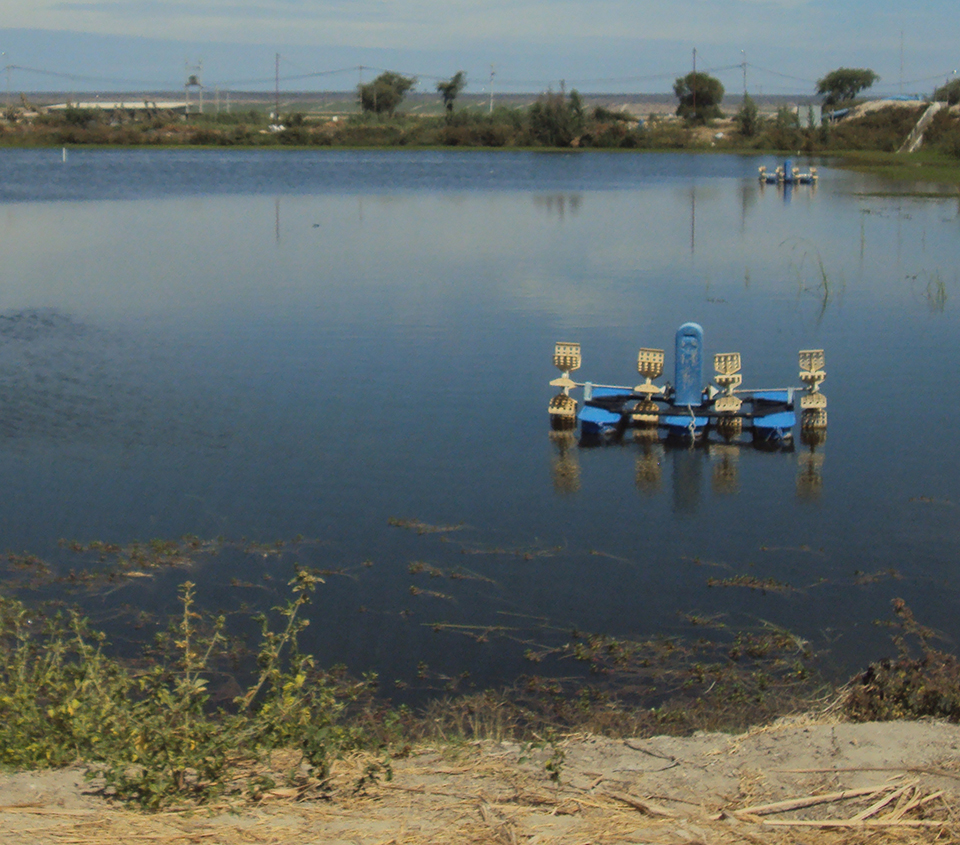Spreading risk across three crops appeals to Indonesian farmers

Soil acidification due to excavation and subsequent aeration of acid sulfate soil causes recurrent production losses and consistently low yields in brackish water aquaculture. Soil pH can fall to below 4, thereby liberating metals that hydrolyze and generate strong mineral acidity. The impacts of soil acidification include mass mortalities, disease, and poor growth rates in stock; reduced beneficial algal blooms due to the loss of available phosphorus; mass precipitation of iron that smothers pond surfaces and the gills of fish and shrimp; and consequent high pond management costs.
Many extensive and semi-intensive ponds have been constructed in acid sulfate soil. The amelioration and management of soil acidity is possible in weakly to moderately acidic ponds, but problematic and prohibitively expensive in severely acidic ponds. Monoculture in severely acidic soils is a high risk activity in which recurrent crop failures often lead to unrecoverable economic losses and pond abandonment.
Polyculture of several species – either as discrete culture systems across a single farm or a polyculture system in each farm pond – spreads risk across crops in ponds that are too severely acidified to remediate for complete grow-out of shrimp under normal monoculture practices.
Alternative culture systems
Work funded by the Australian Centre for International Agricultural Research studied the culture of juvenile shrimp, milkfish, and the macroalga Gracilaria verrucosa in formerly degraded shrimp monoculture ponds in South Sulawesi, Indonesia. The extensive shrimp ponds were abandoned due to repeated crop failures caused by strongly acidic soil with pH below 3 and elevated concentrations of aluminum and iron.
Attempts to remediate the soils for monoculture using lime and increased water exchange failed due to high concentrations of iron precipitated in the ponds, the toxic effects of aluminum on shrimp, difficulties sustaining beneficial algal blooms, and the high cost of maintenance. The alternative production systems were tried because of their lower cost and lack of reliance on a single crop for income.
Juvenile shrimp production was selected because of its short growth period of only 21 days. The probability of a toxic event associated with a flux of acid and toxic metals is low over 21 days when compared to a three month growth period in shrimp monoculture.
The system also utilized net enclosures called hapas to stop stock from burrowing into the pond bottom and pond walls, where hydrogen sulfide and fluxes of acid and toxic metals occur. The hapas also reduced the effects of finely divided iron oxyhydroxides.
Additionally, farmers were able to relocate hapas to ponds with better water quality if the initial pond environments degraded. The demand for juvenile shrimp for stocking other ponds in the region was also a factor in selecting this production system.
The second species farmed was milkfish, which has a higher tolerance to degraded pond conditions than shrimp. Although susceptible to the toxic effects of acid, the addition of lime and increased water exchange maintained conditions within the tolerance limits of this species.
The third crop was the red macroalga G. verrucosa, which has a high acid tolerance and a capacity to reduce the toxic effects of metals in the pond water. Milkfish feed on the epiphytes that grow on the G. verrucosa and improve its marketability.
Pond preparation
Acidic pond bottom soils were limed at a rate of 1 to 2 tons dolomite per hectare, depending on the acidity of the soil. Related laboratory and field trials have shown the effects of liming can be increased by applying it in a slurry to reduce the encapsulation of lime granules by metals and improve penetration into the soil through pores and cracks. In a related study, dolomite produced statistically significant improvements in yield when compared to other liming agents.
To reduce the risk of water acidification, lime was integrated into the upper dike soil layers at 1 to 2 kilograms per cubic meter rather than spread onto the dyke surface. Field experiments on dike soil improvement showed the inner soil layers were significant sources of acid due to the mechanical and chemical diffusion of acid and dissolved metals that contribute to acid production in the pond water. Lime was fully integrated into reconstructed dikes, or surrogate soils that did not produce acid were used.
Urea and triple superphosphate were added to the acidic pond soils at 75 to 150 and 50 to 100 kilogram per hectare, respectively, after liming to compensate for nutrient losses caused by the acid and elevated metals. The fertilizers increased the natural food for the shrimp and milkfish. Urea was also added every two weeks at 10 percent of each initial dosage rate to maintain pond nutrients and algal blooms.
Juvenile shrimp production

Under polyculture, juvenile shrimp were grown in hapas covering no more than 25 percent of the pond surface. The remaining pond environment was used for milkfish and/or G. verrucosa culture. Each 5- x 3- x 1-meter hapa was stocked with a maximum of 15,000 PL11 and harvested after 21 days. Cannibalism and some diseases can present a problem at this stocking density, although survival rates up to 76 percent were achieved during field trials.
Shrimp were fed 3 times per day with commercial crumbled feed at 100, 50 and 20 percent of their total body weight during the first, second and third weeks, respectively. Pond water was exchanged at a rate of 20 percent every two or three days.
The hapas improved stock management by enabling farmers to monitor and isolate disease, and prevent the cannibalization of infected stock by the populations in other hapas. They also helped control predators and allowed easy harvesting of stock. The harvested juvenile shrimp, sold at profits of up to 300 percent, were sought after by other farmers because of their high survival rates in full grow-out monoculture ponds.
Milkfish production
Stocked at a density of 2,000 fry per hectare under polyculture, milkfish improved the quality of G. verrucosa by grazing on other algae and epiphytes. Up to 80 percent survival of the milkfish was achieved following the liming strategy above and tidal exchange through screened gates to buffer water pH. An additional 30 percent of the pond water was exchanged every 21 days if juvenile shrimp were grown in the same ponds.
In early trials, the taste of the milkfish was tainted. To improve taste, the fish were harvested two weeks after G. verrucosa was removed for drying, depending on the progress of the culture system. Milkfish could also be transferred to other ponds with no G. verrucosa to complete the grow-out.
Farmers successfully moved milkfish with no handling by maintaining a higher hydraulic head in the proposed grow-out ponds and then opening a sluice gate or bund screen. The flowing water triggered the milkfish to migrate from one pond to the other. The milkfish were harvested when they achieved an individual weight of 0.4 to 0.5 kg.
G. verrucosa production
Locally collected G. verrucosa stocked at 800 kilograms per hectare (wet weight) generated 5 tons per hectare (dry weight) over a three-month period using the spread method. Progressive harvests commenced at 40 days after stocking.
Iron oxyhydroxides that precipitated onto the alga were washed off before drying. Excessive accumulation of iron can affect growth and requires mechanical removal either by increasing water circulation or agitating the alga. No crop failures were experienced during field trials at a number of locations in South Sulawesi.
G. verrucosa was also used to filter water into the other production systems when each species was farmed separately. It was also successfully grown in retention ponds and canals. Filtered water had significantly lower concentrations of harmful iron oxyhydroxides.
Conclusion
When farmed in discrete ponds or under polyculture, juvenile shrimp, milkfish, and the macroalga Gracilaria verrucosa proved to be viable alternatives to shrimp monoculture in formerly abandoned extensive and semi-intensive ponds in Indonesia. The ability to spread risk across three crops at one farm was appealing to farmers because income was not dependent on the successful completion of all systems or reliant on a single species.
Potential failures in juvenile shrimp production systems involve smaller and more recoverable economic losses than shrimp monoculture, where total crop failure can occur close to the end of the production cycle. Juvenile shrimp culture systems are recommended for ponds that are too costly to manage for monoculture either because of the large amounts of lime and pumping costs required to manage pond pH or the impracticality of applying treatments in remote village areas. An economic analysis of juvenile shrimp systems determined that 20 percent of the profits are required for maintenance.
(Editor’s Note: This article was originally published in the June 2003 print edition of the Global Aquaculture Advocate.)
Now that you've reached the end of the article ...
… please consider supporting GSA’s mission to advance responsible seafood practices through education, advocacy and third-party assurances. The Advocate aims to document the evolution of responsible seafood practices and share the expansive knowledge of our vast network of contributors.
By becoming a Global Seafood Alliance member, you’re ensuring that all of the pre-competitive work we do through member benefits, resources and events can continue. Individual membership costs just $50 a year.
Not a GSA member? Join us.
Authors
-
Jes Sammut, Ph.D.
Geography Program
Faculty of the Built Environment
University of New South Wales
Sydney NSW 2052, Australia -
Akhmad Mustafa, Ir, M.S.
Geography Program
Faculty of the Built Environment
University of New South Wales
Sydney NSW 2052, Australia -
Adi Hanadi, Ph.D.
Gondol Research Institute for Mariculture
Buleleng, Bali, Indonesia -
Suwardi Tahe, Ir
Research Institute for Coastal Fisheries
Maros, South Sulawesi, Indonesia
Related Posts

Responsibility
Appraising pond liners for shrimp culture
The use of plastic-lined ponds by shrimp farmers can significantly improve production efficiency, support more production cycles per year, and higher mechanical aeration rates and stocking densities. The capital cost of lining ponds can be very significant, so a thorough feasibility analysis is recommended when considering this production tool.

Responsibility
Examining copper use in aquaculture
Copper is used for control of the blue-green algae responsible for off-flavors in aquaculture animals, treating diseases and parasites, and avoiding cage net fouling. Although copper is an essential nutrient for plants and animals, an excess can negatively affect the environment and human health.

Health & Welfare
Manage pH cycles to maintain animal health
The ideal pH for most aquaculture species is between 6.0 and 8.5. Lower pH values may result in decreased growth and survival, and greater susceptibility to disease. pH typically is lowest in the early morning, increases during the afternoon and declines at night.

Responsibility
Reactions between pond bottom soil, water
Alkalinity and acidity in pond water and soil interact and can result in unhealthy culture conditions. Ion exchange occurs between soil and water until an equilibrium is reached.


